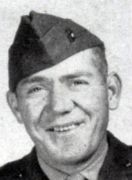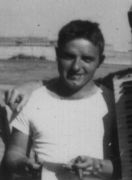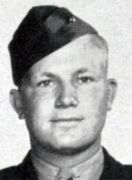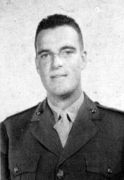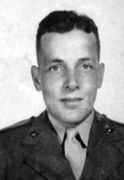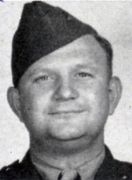Welcome to the Connellsville Canteen!
An Initiative of the Fayette County Cultural Trust


Robbins, Franklin C.
Clearing Blockhouses On Namur – 1944
Note: The following action is described in Phil Wood’s letter of April 2, 1944. From his letter, it would appear that Sergeant Arthur Ervin was part of this “task force” – although he won the Navy Cross as well, he was not available for interview, having been wounded three times.
The Daily Courier, Connellsville PA
Wednesday March 22, 1944
MARINE CORPORAL FRANKLIN C. ROBBINS IN SUCCESSFUL ATTACK ON NAMUR ISLAND HELPS CLEAN OUT JAPANESE PILLBOXES
(The following story was written by Staff Sergeant Dick Tenelly of Washington DC, a Marine Corps Combat Correspondent)
NAMUR ISLAND, Kwajalein Atoll, Marshall Islands (Delayed) - A small group of Marines put up one of the finest displays of individual and group heroism of the entire Marshalls operation when their impetuousness carried them away from the main body of the support landing team, on the afternoon of the first day of the attack on Namur.
There were no more than a dozen of them, but before the day was out, more than half of them had to be evacuated with wounds. In these few hours, they covered a strip of enemy fortifications almost 400 yards long, fighting every inch of the way.
Roy Wood, Third Platoon, Co. A.
First Lieutenants Roy I. Wood, 22, of Greenville N.C. and Harry D. Reynolds Jr, of Mount Vernon NY were leading the remnants of their platoons when they were halted by heavy rifle fire from an enemy pillbox.
Sergeant Frank A. Tucker, 30 of Hugo Okla, came in toward the side of the pillbox about that time. He had come up alone, or so he thought. We watched for a few minutes. Then a lone Japanese rifleman emerged from the pillbox straight toward him. Sergeant Tucker dropped him in his tracks.
James Adams, Battalion Intelligence Section
The entire group then moved along the shore. The Japanese were thick in a wide, deep trench, interspersed at frequent intervals by underground dugouts from which came rifle and machine gun fire. Platoon Sergeant James Adams of Orange, N.J., personally knocked out one enemy machine gun in this advance along the trench. He was standing up firing pointblank at enemy riflemen, when he himself was hit.
Harry Reynolds, Executive Officer, Co. A
Sergeant Tucker, in the van of the movement along the trench, found himself behind a small tree trunk, barely 15 yards from the protected place from which the Japanese had decided to renew their stand.Bits of bark flew off the tree about his head. His water canteen and helmet were punctured by enemy bullets. A bit to one side, a Japanese machine gun cut him off from rejoining the other Marines. But Sergeant Tucker was not scratched.
Lester Kincaid, Co. A
Two Browning automatic riflemen, Private First Class Lawrence E. Knight of Heth, Ark. and Private First Class Lester C. Kincaid of Tango, W. Va., brought their deadly weapons to bear upon the enemy to cover Sergeant Tucker’s withdrawal to their own position.
Lawrence Knight, Co. A.
Private First Class Knight was wounded at about this time. He begged to be permitted to remain in the fight, and only was evacuated on strict orders.
Darkness came on. The remainder of the Marines stayed where they were, crouching in shellholes or behind frayed tree trunks, face to face with an enemy they couldn’t see. During the night, one Marine tossed a grenade upon hearing a noise, and a dead Japanese fell into the hole on top of him.
The Japanese repeatedly sent up flares to locate the Marines. Bullets flew throughout the night. No one slept.
Next day came the final Marines attack, assisted by tanks, which relieved the small group of Marines and ended in the death or capture of the last of the Japanese.
Today, this “task force” or the remnants of it, are erecting tents and sandbag barricades on the spot where the Japanese made their last unavailing stand.
During this action, Arthur Ervin, Lawrence Knight, and Harry Reynolds were wounded.
James Adams was killed.
The Navy Cross was awarded to Arthur Ervin and Frank Tucker.
The Silver Star was awarded to Harry Reynolds, James Adams, and Franklin Robbins.
Navy Cross Awarded
ROBBINS, FRANKLIN C.
Citation:
The President of the United States takes pleasure in presenting the Navy Cross to Franklin C. Robbins (433097), Corporal, U.S. Marine Corps, for extraordinary heroism while serving as a Squad Leader of Company C, First Battalion, Twenty- Fourth Marines, FOURTH Marine Division, in action against enemy Japanese forces during the assault and invasion of Iwo Jima, Volcano Islands, from 19 February to 1 March 1945. Under heavy machine-gun and sniper fire from a ridge cave to the left front, Corporal Robbins with two of his men covering his movements, worked his way to the top and along the ridge until he was directly over the entrance to the cave. Placing a demolition charge in the mouth of the cave, he succeeded in annihilating the enemy troops and destroying their weapons and prevented further use of the cave. When a well-camouflaged pillbox was discovered to be the source from which intense machine-gun, rifle and mortar fire was bearing on his company on 1 March, Corporal Robbins voluntarily braved intense enemy fire to advance in front of a tank and lead it to a position from which it fired on the pillbox and destroyed it. Painfully wounded during this gallant action, Corporal Robbins, by his cool and courageous initiative and his devotion to duty, was directly instrumental in neutralizing an enemy position, thereby upholding the highest traditions of the United States Naval Service.
Fleet Marine Force, Pacific: Serial 48443 (June 23, 1950) (Upgraded from Silver Star)
